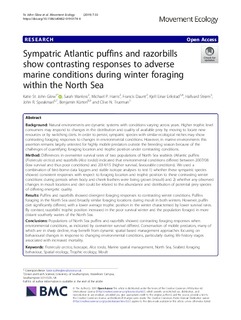| dc.contributor.author | St.John Glew, Katie | |
| dc.contributor.author | Wanless, Sarah | |
| dc.contributor.author | Harris, Michael P. | |
| dc.contributor.author | Daunt, Francis | |
| dc.contributor.author | Erikstad, Kjell Einar | |
| dc.contributor.author | Strøm, Hallvard | |
| dc.contributor.author | Speakman, John R. | |
| dc.contributor.author | Kürten, Benjamin | |
| dc.contributor.author | Trueman, Clive N. | |
| dc.coverage.spatial | North Sea | nb_NO |
| dc.date.accessioned | 2019-11-26T11:10:49Z | |
| dc.date.available | 2019-11-26T11:10:49Z | |
| dc.date.issued | 2019 | |
| dc.identifier.issn | 2051-3933 | |
| dc.identifier.uri | http://hdl.handle.net/11250/2630473 | |
| dc.description.abstract | Background: Natural environments are dynamic systems with conditions varying across years. Higher trophic Level consumers may respond to changes in the distribution and quality of available prey by moving to locate New resources or by switching diets. In order to persist, sympatric species with similar ecological niches may show contrasting foraging responses to changes in environmental conditions. However, in marine environments this assertion remains largely untested for highly mobile predators outside the breeding season because of the challenges of quantifying foraging location and trophic position under contrasting conditions.
Method: Differences in overwinter survival rates of two populations of North Sea seabirds (Atlantic puffins
(Fratercula arctica) and razorbills (Alca torda)) indicated that environmental conditions differed between 2007/08 (low survival and thus poor conditions) and 2014/15 (higher survival, favourable conditions). We used a combination of bird-borne data loggers and stable isotope analyses to test 1) whether these sympatric species showed consistent responses with respect to foraging location and trophic position to these contrasting Winter conditions during periods when body and cheek feathers were being grown (moult) and 2) whether any observed changes in moult locations and diet could be related to the abundance and distribution of potential prey species of differing energetic quality.
Results: Puffins and razorbills showed divergent foraging responses to contrasting winter conditions. Puffins foraging in the North Sea used broadly similar foraging locations during moult in both winters. However, puffin diet significantly differed, with a lower average trophic position in the winter characterised by lower survival rates. By contrast, razorbills’ trophic position increased in the poor survival winter and the population foraged in more distant southerly waters of the North Sea.
Conclusions: Populations of North Sea puffins and razorbills showed contrasting foraging responses when
environmental conditions, as indicated by overwinter survival differed. Conservation of mobile predators, many of which are in sharp decline, may benefit from dynamic spatial based management approaches focusing on behavioural changes in response to changing environmental conditions, particularly during life history stages associated with increased mortality. | nb_NO |
| dc.language.iso | eng | nb_NO |
| dc.relation.ispartofseries | Movement Ecology; | |
| dc.rights | Navngivelse 4.0 Internasjonal | * |
| dc.rights.uri | http://creativecommons.org/licenses/by/4.0/deed.no | * |
| dc.subject | Fratercula arctica | nb_NO |
| dc.subject | Isoscape | nb_NO |
| dc.subject | Alca torda | nb_NO |
| dc.subject | Marine spatial management | nb_NO |
| dc.subject | North Sea | nb_NO |
| dc.subject | Seabird foraging behaviour | nb_NO |
| dc.subject | Spatial ecology | nb_NO |
| dc.subject | Trophic ecology | nb_NO |
| dc.subject | Moult | nb_NO |
| dc.title | Open Access Sympatric Atlantic puffins and razorbills show contrasting responses to adverse marine conditions during winter foraging within the North Sea | nb_NO |
| dc.type | Peer reviewed | nb_NO |
| dc.type | Journal article | |
| dc.rights.holder | © The Author(s) 2019 | nb_NO |
| dc.subject.nsi | VDP::Matematikk og Naturvitenskap: 400::Zoologiske og botaniske fag: 480 | nb_NO |
| dc.source.volume | 7 | nb_NO |
| dc.identifier.doi | 10.1186/s40462-019-0174-4 | |
| dc.identifier.cristin | 1750081 | |

